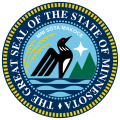| |||||||||||||||||
| |||||||||||||||||
| |||||||||||||||||
The 1900 Minnesota lieutenant gubernatorial election was held on November 6, 1900, in order to elect the Lieutenant Governor of Minnesota. Incumbent Republican Lieutenant Governor Lyndon A. Smith defeated Democratic-People's nominee Thomas J. Meighen, Prohibition nominee C.B. Wilkinson and Midroad Populist nominee Erick G. Wallinder. [1]


